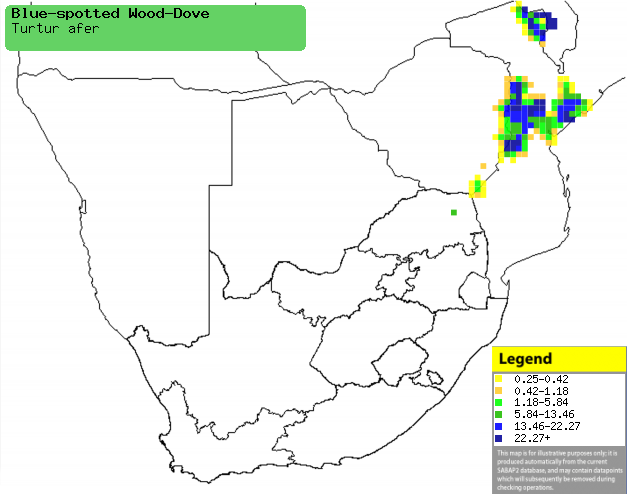|
Turtur afer (Blue-spotted
wood-dove, Blue-spotted dove)
Blouvlekduifie [Afrikaans]; Staalvlekduif [Dutch];
Tourtelette améthystine [French]; Stahlflecktaube [German];
Rola-de-manchas-azuis [Portuguese]
Life
> Eukaryotes >
Opisthokonta
> Metazoa (animals) >
Bilateria >
Deuterostomia > Chordata >
Craniata > Vertebrata (vertebrates) > Gnathostomata (jawed
vertebrates) > Teleostomi (teleost fish) > Osteichthyes (bony fish) > Class:
Sarcopterygii (lobe-finned
fish) > Stegocephalia (terrestrial
vertebrates) > Tetrapoda
(four-legged vertebrates) > Reptiliomorpha > Amniota >
Reptilia (reptiles) >
Romeriida > Diapsida > Archosauromorpha > Archosauria >
Dinosauria
(dinosaurs) > Saurischia > Theropoda (bipedal predatory dinosaurs) >
Coelurosauria > Maniraptora > Aves
(birds) > Order: Columbiformes > Family:
Columbidae > Genus: Turtur
The Blue-spotted wood-dove occurs across sub-Saharan Africa,
absent from large areas of east-central and southern Africa. It usually occurs
on the edges of evergreen or gallery forest, occasionally moving into the
surrounding bush. Its diet has not been properly studied, however it is probably
omnivorous, foraging mainly on the ground. The nest is a fragile saucer, made up
of twigs, petioles and rootlets, usually placed on a leafy stump, tree or bush.
Here it lays about 2 eggs, which are incubated for about 15-17 days. The chicks
stay in the nest for roughly 15-18 days (recorded in captivity).
Distribution and habitat
Occurs across sub-Saharan
Africa, absent from parts of Tanzania, Kenya and Somalia. In southern Africa it
is confined to north-central Mozambique bordering on eastern Zimbabwe, with one
or two localized populations in Limpopo Province. It usually occurs on the edge
of evergreen or gallery forest, occasionally moving into the surrounding bush.
|
 |
|
Distribution of Blue-spotted wood-dove in southern Africa,
based on statistical smoothing of the records from first SA Bird Atlas
Project (©
Animal Demography unit, University of
Cape Town; smoothing by Birgit Erni and Francesca Little). Colours range
from dark blue (most common) through to yellow (least common).
See here for the latest distribution
from the SABAP2. |
Food
Its diet has not been properly studied, however it is
probably omnivorous, foraging mainly on the ground.
Breeding
- Its breeding habits are little known, but it is
presumed to be a monogamous, solitary nester.
- The nest is a fragile sauce of twigs, petioles and rootlets, typically placed on a leafy stump, tree or bush.
- Egg-laying season is from about April-December, peaking from
September-October.
- It lays about two eggs, which are incubated for about 15-17 days.
- The chicks stay in the nest for roughly 15-18 days (recorded in
captivity).
Threats
Not threatened.
References
-
Hockey PAR, Dean WRJ and Ryan PG 2005. Roberts
- Birds of southern Africa, VIIth ed. The Trustees of the John Voelcker
Bird Book Fund, Cape Town.
|
